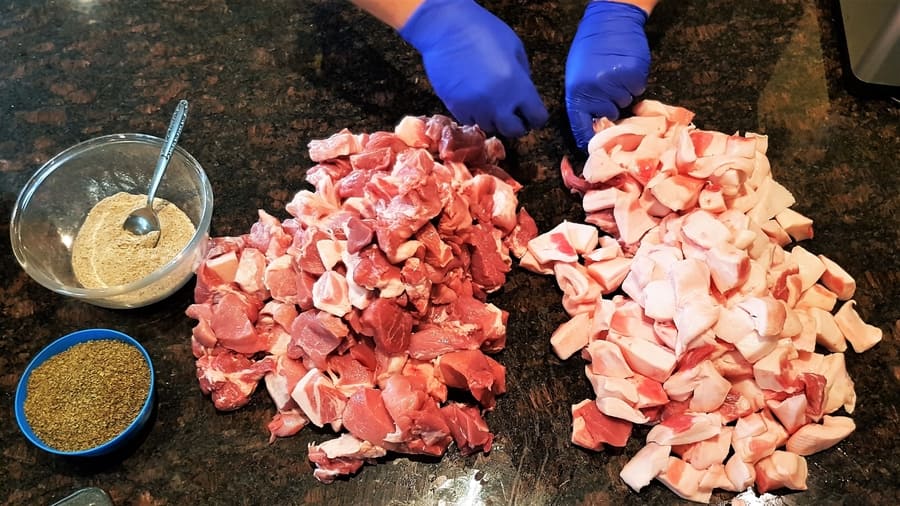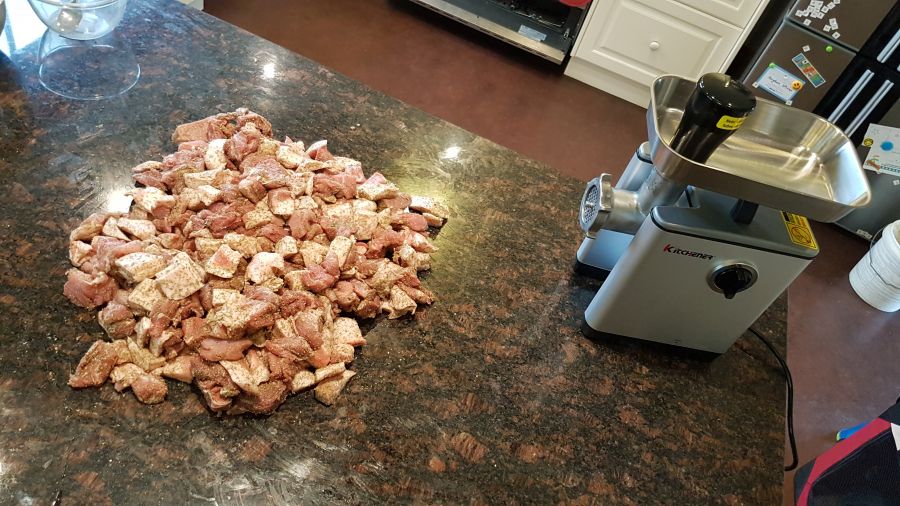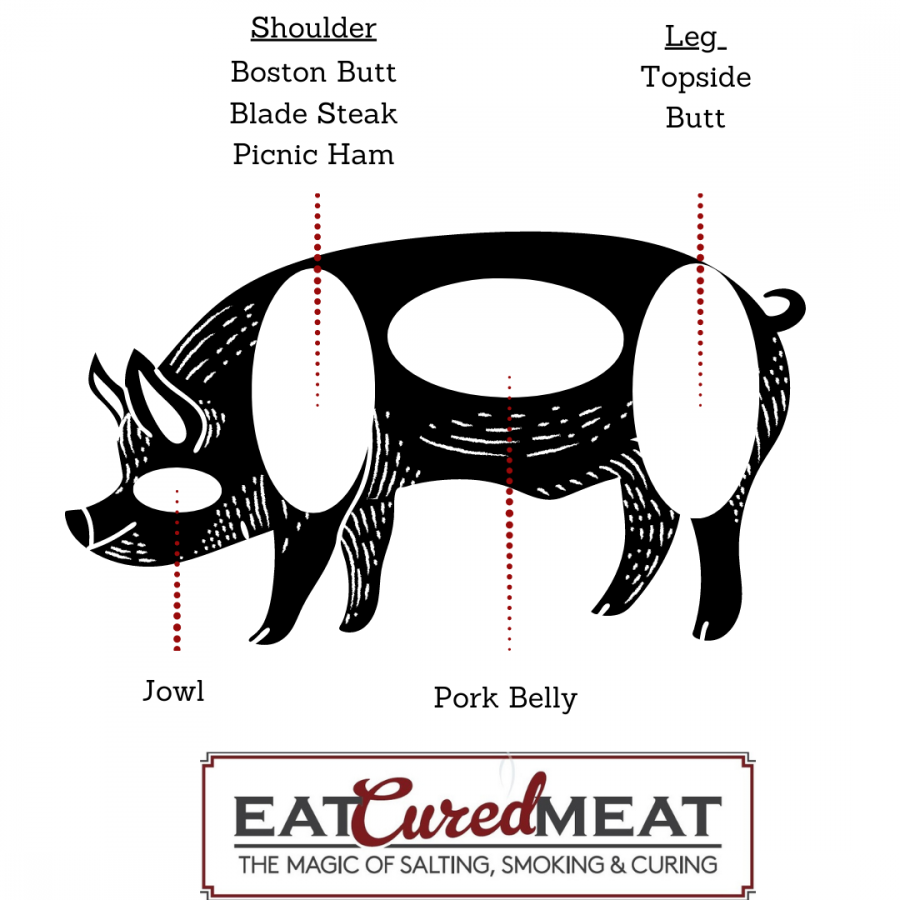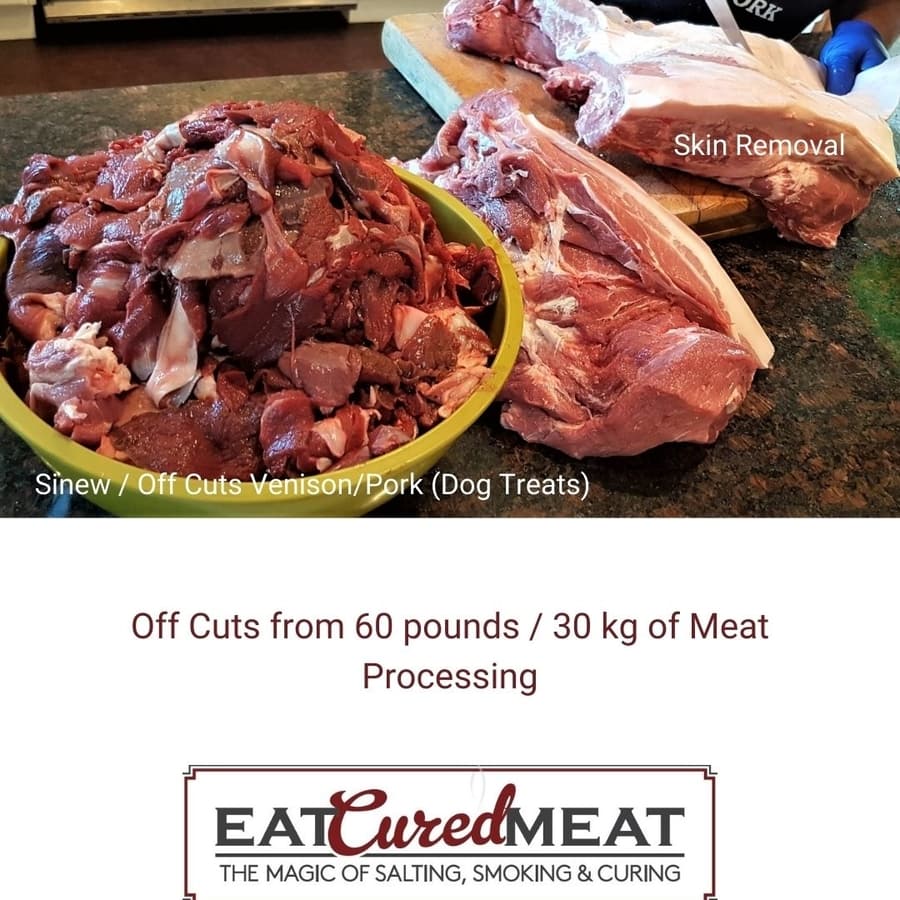When making sausages at home, the type of fat you want to use sometimes depends on the fat you can get.
Key Points:
- Choosing the right fat for homemade sausages is crucial for flavor and texture.
- Back fat is ideal due to its hardness and high melting point, followed by jowl fat and fat from Boston butt or shoulder.
- Soft pork fat, such as pork belly fat, can also be used, but caution is required to maintain a near-freezing temperature.
- Aim for a 20-30% fat-to-meat ratio for optimal sausage texture.
- Different pork cuts like shoulder, belly, or jowl offer unique flavors and textures.
- Tips below: Remove sinew, test bind, and fry a small patty for texture.
- Fats like beef, chicken, or lamb can be used but may alter the flavor. However, they have different flavors than neutral pork fat.
The big assumption is that all fat is the same – but it is not quite like that.
When making sausages, it’s either fresh sausage, smoked/cooked (hot smoked) sausage, or a type of dry-cured salami sausage; I love making all of them, so I started this website: eat cured meat.
I want to elaborate on the best techniques I’ve discovered to make my sausage with fat over the years.
All pork fat is not the same because it depends on what part of the pig it comes from.

Important factors are also how hard the fat is and its melting point.
Pure back fat is the best choice; Boston butt or shoulder fat is an alternative depending on the ratio of meat to fat. Often this ratio is 20-25% fat in Boston butt or shoulder which is suitable for sausage making.
Different Types of Pork Fat for Sausage
| Type of Pork Fat | Consistency | Melting Point | Good for Sausage |
| Back Fat | Hard | High | Yes |
| Jowl | Hard | High | Yes |
| Boston Butt or Shoulder | Hard | High | Yes |
| Pork Belly | Soft | Low | No (will still work) |
| Flare Fat | Soft | Low | No |
Hard Pork Fat
Quality back fat or fatty pork belly is perfect for making homemade sausage.
My back-fat resources for making sausages or salami are a commercial bacon company and an excellent local butcher.
About 15 years ago, when I started making sausages, I could get pork fat-free from any butcher. The challenge nowadays is that many butchers don’t cut up animals anymore – they are retailers sometimes.
Their meats/sausages arrive in boxes already processed at a central meat works, and they will then be displayed and sold.
The other day, I was lucky to see a pig’s head for sale. To take the jowl off was relatively straightforward. First, I wanted to use it for sausages, but I decided to make a dry-cured Guanciale (the classic for traditional carbonara)) from each one; they say it’s like pancetta but different.
It was quite a firm piece of pork; I extracted the first from a pig’s head. It was interesting to see the texture and the interconnective fat embedded in the meat.
It was similar to the marbled fat of a Boston pork cut from the upper shoulder (it depends, of course, on the age of the pig).
As you can imagine, this part of the animal’s head gets a lot of muscle movement from chewing. So, this meat was substantial compared to all the other cuts of pork I use.
Shoulder or Boston butt carries marbling fat throughout the meat rather than white fat and separated meat (if you get a whole shoulder, you do get bands of this as well). That is why it’s popular for low & slow bbq smoking/cooking because the embedded fat will melt and moisten the meat when it’s cooked in the butt.
When making sausages, you can see the meat or fat you’ll be grinding and whether it has more or less fat than the meat – to figure out your ratio (more on this below).
I am not talking about the different types of fresh sausages that are emulsified or processed for a more generic texture, such as hot dogs or baloney.
Soft Pork Fat
Pork belly can still work when making sausages – it’s only an issue if you don’t keep it at or near freezing point temperature.
If you’re learning about sausages, this is one of the key points to remember: Always have your meat and fat at the near near-freezing point.
With the mechanical process of mincing or grinding meat, the movement will create heat, and the heat can smear/mix the meat and fat, which is not ideal when making sausages.
Unless your target is an emulsified, more generic consistency.
I’ve used pork belly to make fresh sausages and salami without an issue, but I’ve also been cautious to keep things around freezing.
That’s why we sometimes use a large 1 (hp) horsepower meat grinder. We place the attachment and auger in the freezer to keep everything a little cooler when the grinding starts. You can also do this with the 1/2 hp grinder below.

What is the Best Fat to Meat Ratio for Sausage
A 20% minimum fat-to-meat ratio is required to make most sausage. The maximum allowed fat in certain commercial sausages is 50%. 25-30% is ideal for many sausage recipes.
It wastes all the effort if you don’t have enough sausage fat. The dryness makes the whole sausage nearly inedible.
Trust me, I’ve been there and done that, but this is not an excellent outcome.
I recently tried to reproduce the 700-year-old Bavarian Nuremberg bratwurst sausage, which you can enjoy in restaurants and as street food around Nuremberg, Germany.
Looking through many recipes for this, I decided on 40% of pork fat. This is a very delicious sausage that melts in your mouth! (LOTS of marjoram, white pepper, allspice)
I’ve also found it hard to judge pork belly regarding the fat-to-meat ratio. It just depends on how fatty the pig is and its age. Often older pigs = more fat!
Generally speaking, 20 to 25% would be a rough guide for the ratio of fat to meat for pork belly.
What Cuts of Meat for Sausage
Shoulder, front leg, back leg, belly, or even the jowl or cheek of pork.

The pig’s head did not have much meat apart from the jowl cheek. The jowl is on the outside of the cheek. Just for information and if you want to cook the tongue, it tastes like liver!
Essential tips I’ve learned over the years for making sausages.
The first tip is to take time to remove the sinew, which is essential for having an excellent finished product. The worst thing is finding bits of connective tissue in the sausage.

Any lymph nodes or non-meat bits should be removed. Blood doesn’t help either and spoils faster than meat. Take your time and remove it as best as you can.
The second big tip is always to test the pattie after you grind it and add salt and spices.
It should be tacky and sticky if you’ve done your binding right by mixing it.
Another tip: If you make patties, squish them onto your palm, and hold your hand upside down, does it fall off? If it does, the meat and fat need more binding, so you must work it more or let the dough hook do it.
I’ve read in meat science textbooks that myosin is released in the meat, creating this desirable ‘tackiness.’
As I said earlier, fry up a little meat patty – try it, and you will know what the finished product would be like.
Another tip – Be extra careful when deboning; I’ve left a cartilage chunk in the meat when deboning a leg of venison. The chunks were spread across 80 pounds / 40 kg of sausage!
Venison, Beef, and many other types of meat can be incorporated, as long as they have that 25% fat (in some recipes where the meats are more emulsified, olive oil or rapeseed oil is added to the meat without the fat).
Remember that you still want a 25% fat-to-meat ratio for a non-emulsified fresh sausage to make it work.
I often use very lean wild meat like venison (I wrote about charcuterie that is not pork here) for my sausages, which has to have added fat.
Using Fat That Isn’t Pork for Sausage
Beef, chicken, and lamb fat can be used for making sausage – although these meats have a different taste that isn’t neutral like pork fat.
Beef Fat
Beef fat is often yellow, so it can change the whole look of these sausages without dabbling into the other additives. Sometimes it’s whiter, maybe depending on whether it is grain- or grass-fed.
Always go for grass-fed; grain-fed is typically more intensively reared.
It has a flavor far from neutral compared to pork fat.
It’s still delightful; it depends on your personal preferences.
Chicken Fat
Chicken sausages with chicken thighs have a lot of fat incorporated into the meat, often intramuscularly. That’s also why, if you fry thighs, it’s tough to overcook them!
I’ve eaten chicken sausages but haven’t made them, so I can’t tell you about this one.
Lamb Fat
It has a taste of its own; again, it’s far from neutral. First, you have to like the fat flavor. The flavor of lamb sausages also depends on the animal’s age and whether it is fed on the mother’s milk only. Older sheep’s meat/fat (mutton) for sausages has a distinctive flavor and needs LOTS of garlic and rosemary for a funky flavor (in my mum’s opinion / it’s a classic combo).
Grind or Cutting Fat for Sausage
It entirely depends on whether you’re making a salami or a fresh sausage and the size of your grinding plates.
For a smaller 25 or 28-mm sausage, a maximum of 4-6 mm when you are grinding would be appropriate.
But for a 50- or 60-mm dry cured salami, you may be better at cubing the 5-12mm fat.
This is important for the type of sausage you want to make. Cubing the fat is another option for a more visual aspect.

Tom Mueller
For decades, immersed in studying, working, learning, and teaching the craft of meat curing, sharing the passion and showcasing the world of charcuterie and smoked meat. Read More
